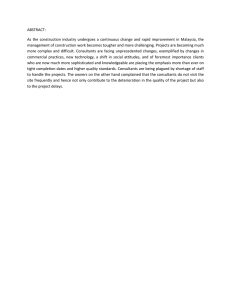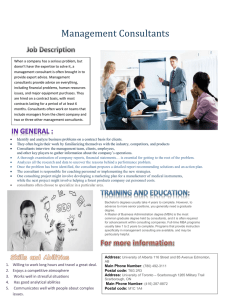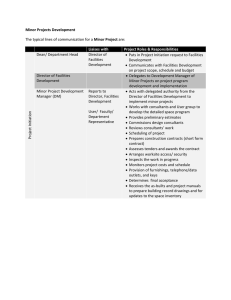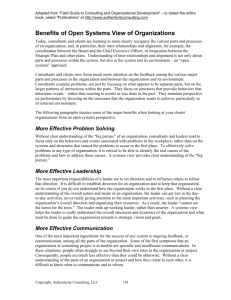Firms must stay tuned to shifting demands
advertisement
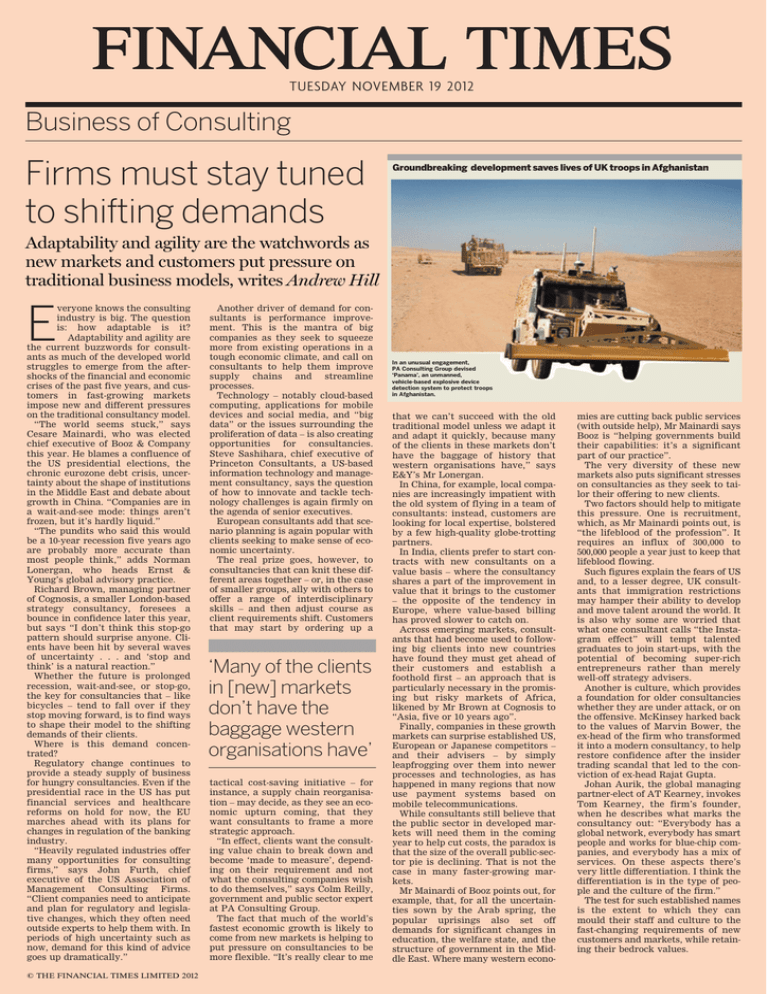
TUESDAY NOVEMBER 19 2012 Business of Consulting Firms must stay tuned to shifting demands Groundbreaking development saves lives of UK troops in Afghanistan Adaptability and agility are the watchwords as new markets and customers put pressure on traditional business models, writes Andrew Hill E veryone knows the consulting industry is big. The question is: how adaptable is it? Adaptability and agility are the current buzzwords for consultants as much of the developed world struggles to emerge from the aftershocks of the financial and economic crises of the past five years, and customers in fast-growing markets impose new and different pressures on the traditional consultancy model. “The world seems stuck,” says Cesare Mainardi, who was elected chief executive of Booz & Company this year. He blames a confluence of the US presidential elections, the chronic eurozone debt crisis, uncertainty about the shape of institutions in the Middle East and debate about growth in China. “Companies are in a wait-and-see mode: things aren’t frozen, but it’s hardly liquid.” “The pundits who said this would be a 10-year recession five years ago are probably more accurate than most people think,” adds Norman Lonergan, who heads Ernst & Young’s global advisory practice. Richard Brown, managing partner of Cognosis, a smaller London-based strategy consultancy, foresees a bounce in confidence later this year, but says “I don’t think this stop-go pattern should surprise anyone. Clients have been hit by several waves of uncertainty . . . and ‘stop and think’ is a natural reaction.” Whether the future is prolonged recession, wait-and-see, or stop-go, the key for consultancies that – like bicycles – tend to fall over if they stop moving forward, is to find ways to shape their model to the shifting demands of their clients. Where is this demand concentrated? Regulatory change continues to provide a steady supply of business for hungry consultancies. Even if the presidential race in the US has put financial services and healthcare reforms on hold for now, the EU marches ahead with its plans for changes in regulation of the banking industry. “Heavily regulated industries offer many opportunities for consulting firms,” says John Furth, chief executive of the US Association of Management Consulting Firms. “Client companies need to anticipate and plan for regulatory and legislative changes, which they often need outside experts to help them with. In periods of high uncertainty such as now, demand for this kind of advice goes up dramatically.” © THE FINANCIAL TIMES LIMITED 2012 Another driver of demand for consultants is performance improvement. This is the mantra of big companies as they seek to squeeze more from existing operations in a tough economic climate, and call on consultants to help them improve supply chains and streamline processes. Technology – notably cloud-based computing, applications for mobile devices and social media, and “big data” or the issues surrounding the proliferation of data – is also creating opportunities for consultancies. Steve Sashihara, chief executive of Princeton Consultants, a US-based information technology and management consultancy, says the question of how to innovate and tackle technology challenges is again firmly on the agenda of senior executives. European consultants add that scenario planning is again popular with clients seeking to make sense of economic uncertainty. The real prize goes, however, to consultancies that can knit these different areas together – or, in the case of smaller groups, ally with others to offer a range of interdisciplinary skills – and then adjust course as client requirements shift. Customers that may start by ordering up a ‘Many of the clients in [new] markets don’t have the baggage western organisations have’ tactical cost-saving initiative – for instance, a supply chain reorganisation – may decide, as they see an economic upturn coming, that they want consultants to frame a more strategic approach. “In effect, clients want the consulting value chain to break down and become ‘made to measure’, depending on their requirement and not what the consulting companies wish to do themselves,” says Colm Reilly, government and public sector expert at PA Consulting Group. The fact that much of the world’s fastest economic growth is likely to come from new markets is helping to put pressure on consultancies to be more flexible. “It’s really clear to me In an unusual engagement, PA Consulting Group devised ‘Panama’, an unmanned, vehicle-based explosive device detection system to protect troops in Afghanistan. that we can’t succeed with the old traditional model unless we adapt it and adapt it quickly, because many of the clients in these markets don’t have the baggage of history that western organisations have,” says E&Y’s Mr Lonergan. In China, for example, local companies are increasingly impatient with the old system of flying in a team of consultants: instead, customers are looking for local expertise, bolstered by a few high-quality globe-trotting partners. In India, clients prefer to start contracts with new consultants on a value basis – where the consultancy shares a part of the improvement in value that it brings to the customer – the opposite of the tendency in Europe, where value-based billing has proved slower to catch on. Across emerging markets, consultants that had become used to following big clients into new countries have found they must get ahead of their customers and establish a foothold first – an approach that is particularly necessary in the promising but risky markets of Africa, likened by Mr Brown at Cognosis to “Asia, five or 10 years ago”. Finally, companies in these growth markets can surprise established US, European or Japanese competitors – and their advisers – by simply leapfrogging over them into newer processes and technologies, as has happened in many regions that now use payment systems based on mobile telecommunications. While consultants still believe that the public sector in developed markets will need them in the coming year to help cut costs, the paradox is that the size of the overall public-sector pie is declining. That is not the case in many faster-growing markets. Mr Mainardi of Booz points out, for example, that, for all the uncertainties sown by the Arab spring, the popular uprisings also set off demands for significant changes in education, the welfare state, and the structure of government in the Middle East. Where many western econo- mies are cutting back public services (with outside help), Mr Mainardi says Booz is “helping governments build their capabilities: it’s a significant part of our practice”. The very diversity of these new markets also puts significant stresses on consultancies as they seek to tailor their offering to new clients. Two factors should help to mitigate this pressure. One is recruitment, which, as Mr Mainardi points out, is “the lifeblood of the profession”. It requires an influx of 300,000 to 500,000 people a year just to keep that lifeblood flowing. Such figures explain the fears of US and, to a lesser degree, UK consultants that immigration restrictions may hamper their ability to develop and move talent around the world. It is also why some are worried that what one consultant calls “the Instagram effect” will tempt talented graduates to join start-ups, with the potential of becoming super-rich entrepreneurs rather than merely well-off strategy advisers. Another is culture, which provides a foundation for older consultancies whether they are under attack, or on the offensive. McKinsey harked back to the values of Marvin Bower, the ex-head of the firm who transformed it into a modern consultancy, to help restore confidence after the insider trading scandal that led to the conviction of ex-head Rajat Gupta. Johan Aurik, the global managing partner-elect of AT Kearney, invokes Tom Kearney, the firm’s founder, when he describes what marks the consultancy out: “Everybody has a global network, everybody has smart people and works for blue-chip companies, and everybody has a mix of services. On these aspects there’s very little differentiation. I think the differentiation is in the type of people and the culture of the firm.” The test for such established names is the extent to which they can mould their staff and culture to the fast-changing requirements of new customers and markets, while retaining their bedrock values.
